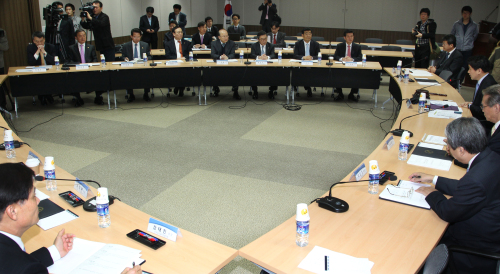Panel starts reviewing where to locate multi-trillion-won facilities
Lawmakers engaged in a heated dispute over a proposal to divide up an envisioned multi-trillion-won science-business belt into two or three different regions as a panel assigned with selecting the location held its first meeting Thursday.
The Lee Myung-bak administration last year sought to set up the science-business belt in South Chungcheong Province as an alternative to the scheduled relocation of government ministries there. But ever since the attempt to revise the Sejong administrative town scheme was rejected by the National Assembly in July, politicians from other parts of the country have eyed the science complex.
Lawmakers from central Chungcheong fiercely protest the reported option of locating only a part of the science-business belt their region and the rest to the southern provinces.
“The government and Cheong Wa Dae say nothing has been decided, but this is not the first time we are seeing something like this (reversing an earlier pledge),” said Rep. Park Sung-hyo, a member of the ruling Grand National Party’s supreme council and former mayor of Daejeon.
“I hope (the issue of locating the science complex) does not go too far beyond policymaking and politics as to undermine the president’s personality.”
Minister of Education, Science and Technology Lee Ju-ho, who chairs the panel in charge of drawing a blueprint for the science complex, said nothing was decided as he presided over its first meeting Thursday.
The 20-person panel consists of vice ministers of science, finance, home affairs, land, knowledge economy and health and welfare as well as 13 representatives of scientist groups.
The panel will finalize the layout for the science-business belt such as its location, budget and how to attract businesses’ investment.
The science complex is to house a heavy-ion accelerator, world-class basic science research organizations and related business facilities.
Some speculate that the government could award at least a part of the science-business belt to Yeongnam to placate public discontent in the region after the reversal of Lee’s election pledge to build a new international airport there.
 |
A panel holds a meeting on selecting the location of a science-business belt at the government office building in Seoul on Thursday. (Yonhap News) |
President Lee on Thursday held closed-door talks with Busan Mayor Hur Nam-sik, during which he explained what led to the government’s decision to ditch the airport plan and reiterated his promise to continue efforts for the region’s development. Lee’s top aide for political affairs was also set to meet with his predecessors under past administrations Friday to seek their advice.
In addition to the option of substituting the airport with the science-business belt, the government is reportedly mulling moving the headquarters of the state-run Korea Land and Housing Corporation, also known as LH, to Yeongnam.
GNP floor leader Kim Moo-sung denied any set plans on the envisioned science complex, referring to the science minister’s remarks that “nothing has been decided.”
Nevertheless, politicians based in Chungcheong slammed the possible retraction of another presidential election pledge. Lee had vowed to build the science complex in Chungcheong in his regional campaign package.
Lee Hoi-chang, leader of the Liberty Forward Party, whose stronghold is the Chungcheong region, said he will quit as the party chairman if the belt goes to another region.
“We can no longer tolerate this politics of distrust, offering compensation for reversing a campaign pledge, splitting up a science business belt to appease another region,” he said.
“I will devote my honor and title for the future of Korea. (The LFP) is willing to unite with another party or faction if it shares our vision for the future.”
LFP floor leader Kwon Sun-taek called the proposed dividing up of the science-business belt “pernicious.”
Assemblymen from the south of the country support the split-up.
GNP’s Rep. Seo Sang-ki, hailing from Yeongnam’s Daegu, championed a “triangular belt” with a 3.5-trillion-won investment each in Chungcheong, Yeongnam and Honam.
Main opposition Democratic Party’s Rep. Kim Young-jin from Honam’s Gwangju said scattering the research and development facilities would create synergy with the existing scientific infrastructure and R&D complexes in Daejeon, Gwangju and Daegu.
By Kim So-hyun (
sophie@heraldcorp.com)







![[Today’s K-pop] Blackpink’s Jennie, Lisa invited to Coachella as solo acts](http://res.heraldm.com/phpwas/restmb_idxmake.php?idx=644&simg=/content/image/2024/11/21/20241121050099_0.jpg)
